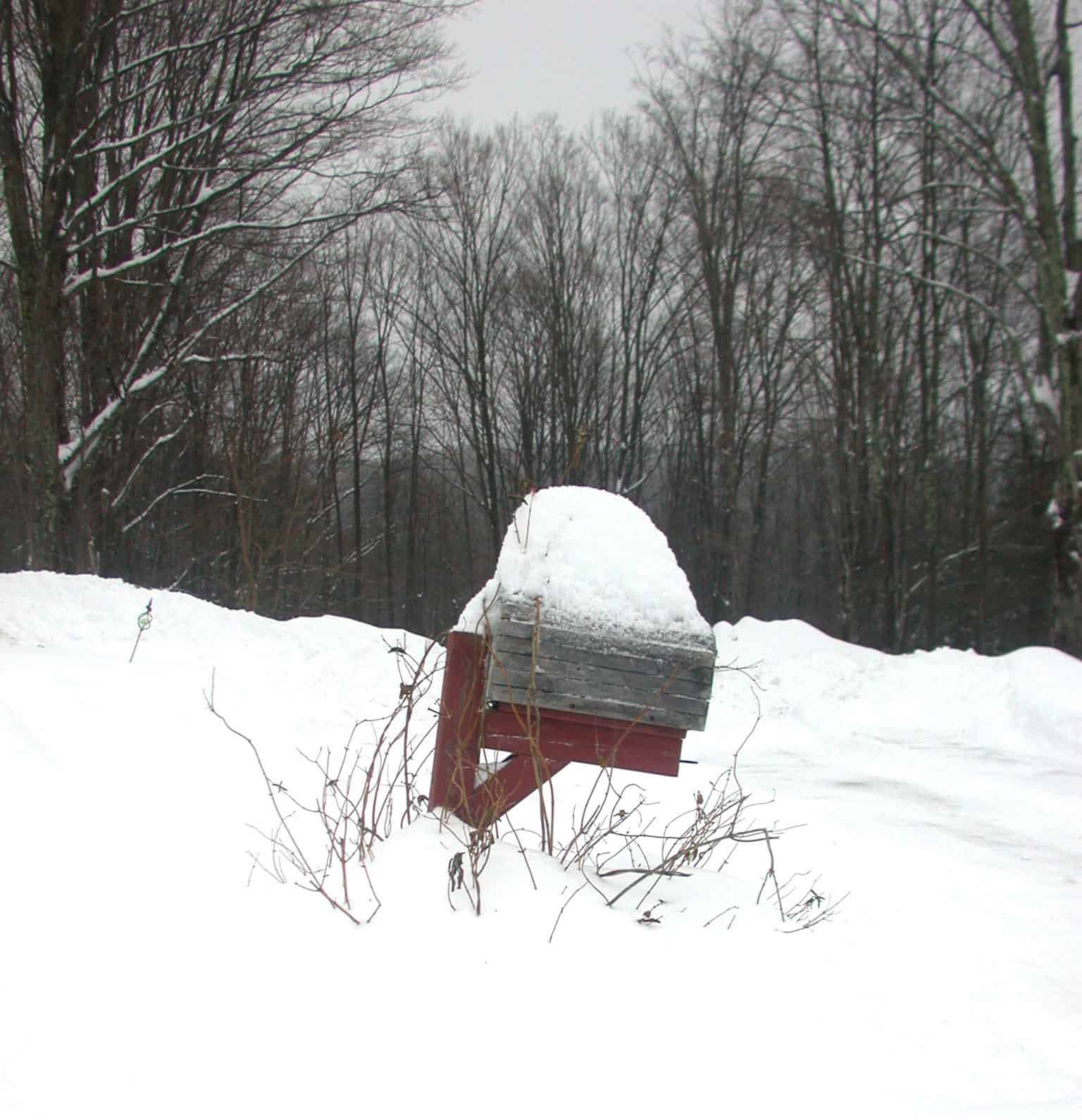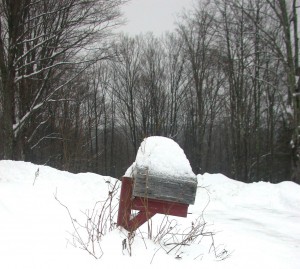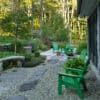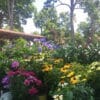By Erica Bowman, JMMDS
Here in Vermont, the snow tends to come in November or December and stay until spring. I happen to love skiing, snowshoeing, sledding, and the warmth of the woodstove fire. I’d be remiss, however, if I didn’t acknowledge that winter also comes with biting cold, slippery ice, shoveling snow, and plowing. As a designer, I know that winter has a way of putting even the best landscape installations to the test. Read on for some design suggestions for any landscape that is susceptible to snow and ice.
Picturesque, yes, but also a nuisance—the USPS won’t deliver mail if the mailbox is inaccessible. Photo: Erica Bowman.
WINTER DESIGN TIPS
Plan for plowing: For places where snow piles up in winter, it is important to make room for the inevitable plowing that will take place. To some extent, the drive-in garage creates an interesting design challenge. You must provide ample space to push and store the snow, or make plans for melting it or hauling it away. The plow also has a way of damaging nearby trees and shrubs, not to mention walls and other garden ornamentation, so it is best to provide a generous buffer between them and the roadway.
Make sure an entrance is accessible in winter: I recently saw a winter walkway nightmare. It was a new, fancy ski house with a huge complicated roof with hips, dormers, and valleys aplenty. All of the drip edges seemed to converge at one point, right over the main door. A steeply spiraling, natural stone stairway led to this doorway. This place was situated on a mountain top, and I am sure that the stairway was intended to reference the craggy wildness of the landscape’s surroundings. This entrance is presumably quite beautiful on a sunny summer’s day. In the winter, however, you probably need a pick-axe and crampons to access this door. You’d also need a hard hat to protect yourself against the falling icicles.

L: Winter observations are essential to good landscape planning: you can make note of the space needed for plowing and piling snow. C: A deep snow load on your roof is a sign of good insulation—but you might also want a sign that says, “Look out below!” R: Daggers of death–don’t place a walkway underneath. Photos by Erica Bowman.
There is nothing wrong with an artistic approach to the house, as long as you have a solid plan for winter accessibility. Some of our clients want creeper-encrusted stepping stones as their main entrance. Others have chosen to include stone bridges and gravel walks as part of a larger entrance experience. For each of these situations we supplied the client with a more user-friendly winter alternative so that we didn’t compromise the art of their chosen three-season walk.
When evaluating any entranceway for winter use, ask yourself these questions: Can the walkway withstand shoveling? Will salt be necessary to melt ice? (Salt can be injurious to plants, stone, and concrete.) Is the distance too long and cold? Will icicles present a hazard? Will the walk become a slipping hazard? Will snow from the roof land on the walk?
Evaluate the snow load before planting near a roof’s drip edge: It’s amazing how much snow can pile up below a roof’s trajectory. Where it falls exactly is determined by a complex combination of factors: the pitch of the roof, its size, and its materiality. The easiest way to figure it is by observation during the winter. It’s important to understand the snow load because it can take a toll on woody plants planted below. Yes, there are A-frame structures you can build to help protect the plants, but perhaps it would be better and easier to plant herbaceous plants in that space, or reserve it for shrubs that enjoy annual coppicing (cutting almost all of the way to the ground to encourage regrowth) like some willows, hydrangeas, cornus, etc.

L: Eastern white pine (Pinus strobus) has poor resistance to salt, as these damaged specimens show. Photo: Maine.gov. C: Northern bayberry (Myrica pennsylvania) has good salt tolerance. Photo: Acorn Farms. R: Japanese yew (taxus cuspidata) is another good choice for salt-tolerant plantings. Photo: The Morton Arboretum.
Plant only salt-tolerant plants near paved roads: For some plants, salt is the kiss of death. It is amazing how far the salt spray can shoot from the blade of a plow. You can observe the extent and height of its damage in the spring when the salt-intolerant trees like white pines and arborvitaes become browned along the roadside. You can counter some of the spray by covering sensitive, established trees with burlap, but you still have to contend with the absorbed salt in the soil. It is best to plan ahead and plant salt-tolerant trees. Some tolerant tree species include: willows, yews, larches, sumac, Colorado spruce, quaking aspens, Ponderosa pines, mulberry, honey locust, black locust, horse chestnut, ginkgo, and white and green ash.
Include plants for winter interest: This seems to be a no-brainer, but it is easy to get carried away by the flowers and foliage of the summer months when everything is green and luscious and forget to provide for winter color and structure. Sometimes when the leaves have fallen and the perennials have been cut down, the garden can take on a sullen appearance. What’s worse, green screens that block unsightly views (neighbor’s house, roads, trash heap) can lose their effectiveness if all of the leaves are gone. Planting evergreen conifers and even broadleaf shrubs (rhododendrons, some viburnums, and mountain laurels) can bring interest to the winter gardenscape and keep those screens effective. Of course plants need not be evergreen to enliven the winterscape. Deciduous trees can also provide needed structure, beauty, depth, and height to the garden. Plants with berries can provide the color that is so scarce this time of year (e.g., winterberry Ilex verticillata or green hawthorn Crataegus viridis ‘Winter King.’) Some plants’ stems take on brilliant hues (such as black raspberry Rubus occidentalis or red-twigged dogwood Cornus sericea) and can be stunning en masse.

Include plants for colorful winter interest. L: Green hawthorn ‘Winter King.’ Photo: Maddox Garden Center. C: Cornus sericea. Photo: Suntrap Garden. R: Ilex vertillicata. Photo: Mary’s Plant Farm.
Plan for the melt ahead of time: Lots of snow melting all at once can create mud, erosion, and wet basements. This is the reason we Vermonters call the season between winter and spring “mud season.” Some of the damage can be controlled by a good grading plan. There should be positive drainage away from all house foundations and off of road surfaces, walks, and patios, and a clear route for all surface drainage on your site. Even the lawn areas should have a slight pitch to allow sheet flow. Avoid dead ends and depressions because they can lead to ponding. Grading mistakes can be fixed retroactively, but it makes sense when planning the construction of a new house to make sure the surface grading is worked into the design. With careful planning, you can even make the drainage plan a garden feature.

L: Vermont’s famous mud season turns our roads to peanut butter. Photo: Mountain Vistas. R: To avoid a similar effect in your garden, incorporate drainage into your landscape design. Photo: This Old House.
Use visual cues to make water features obvious in the snowy months: Ponds and pools can be dangerous in the winter months, especially those with shallow banks. When frozen and covered with snow there can be little to distinguish them from the neighboring lawn or field, making them hazardous for unsuspecting pedestrians and skiers alike. The ice may be too thin for walking although thick enough to sustain a snow load. Some golf courses erect temporary snow fences around their ponds for this reason. Planting around your pond or pool and adding boulders, ornaments, and changes in elevation will make for a more attractive oasis in the summer months and a less dangerous area under snow.








Erica,
A very good and informational post. I have a cute post up on winter interest and will link to your post for the serious information they should consider, since I included none of this and it is good to know. Donna
Thanks Donna. I will check out your post as well.
Erica
Wow. So many things to consider, and so many reasons why I live down here. Great article, Erica.